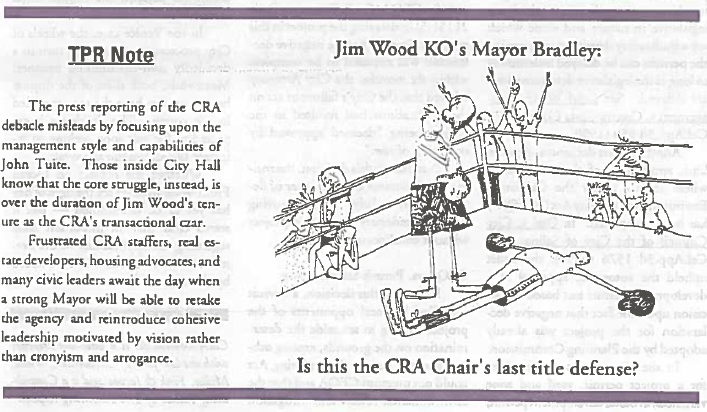The year 1990 brought many changes in the regulatory framework governing planning and land use in the Los Angeles area. What follows is a selective guide to some of the most important developments in planning and land-use during 1990, all of which will affect Los Angeles area development into 1991 and beyond.

Ken Bernstein
"With the Sewer Hook-Up Ordinance, environmental constraints began to shape growth management in 1990."
CITY OF LOS ANGELES
Downtown TRIP Fee/ICO
During the late summer and early fall, the hottest downtown planning issue was the proposed downtown transportation Interim Control Ordinance, which contained a notice provision for a downtown TRIP (Transportation Reduction Improvement Program) fee.
The downtown business community, considering passage of the ICO virtually inevitable, focused its lobbying on obtaining exemptions to the fee, including an exemption for hotels. After consideration and changes by several Council committees, the ordinance has gone back to the City Attorney’s office, and is expected to reemerge on the Council floor by late January or early February.
Ventura Corridor Specific Plan
The Ventura Boulevard Specific Plan neared passage in 1990, affecting the entire 17 miles of Ventura Boulevard across the San Fernando Valley. The plan contains height limits, design guidelines, limits on new trips generated, and transportation infrastructure improvements. The plan also establishes a TRIP fee which varies among the Valley’s five affected communities depending on traffic levels. Final approval of the plan came in the early days of 1991.
Site Plan Review
On May 29 the City Council approved the Site Plan Review Ordinance, a measure designed to comply with the 1987 Friends of Westwood decision. The ordinance, which became effective in October, establishes a two-tiered structure of discretionary review. The first tier is a conditional use procedure through the Planning Commission for nonresidential and hotel projects exceeding 100,000 sq. ft., 250 hotel rooms, or 250,000 sq. ft. of warehouse floor area. The second tier, Site Plan Review, is required for projects exceeding 35 units or larger, non-residential projects with total floor area between 40,000 and 100,000 sq. ft., and changes of use resulting in 500 or more additional vehicle trips.
Sewer Hook-Up Ordinance
With the Sewer Hook-Up Ordinance, environmental constraints began to shape growth management in 1990. The City Council approved a replacement Sewer Hook-up Ordinance on June 26th, setting a cap of five million gallons per day. Of that capacity, 34.5% will go to priority projects (those projects meeting 16 categories of public policy goals enumerated in the ordinance), and 8% will go for “Public Benefit Projects” at the discretion of the Council. The remaining 57.5% allocated for nonpriority projects will be divided 65% for residential and 35% for non-residential projects.
A New Housing Department
At the start of 1990 it appeared that the City of Los Angeles might get a long-discussed Housing Commission to coordinate housing policy and production. But homing advocates eventually got the City to establish a full-fledged Housing Preservation and Production Department, whose activities would be overseen by the Housing Commission.
Former mayoral aide and non profit housing activist Guy Squier was named in October to direct the agency and Chuck Elsessor, an aide to Senator David Roberti, was elected President of the Commission. But by year’s end the biggest question mark remained funding, with the rejection by Los Angeles voters of Proposition K, a $100 million bond issue.
Resignation of John Tuite
On December 28th, John Tuite resigned as administrator of the CRA, after many weeks of speculation about his removal. The changing of the guard comes after the CRA has received criticism for not devoting enough attention to affordable housing issues. This event will reverberate into 1991, with calls for a Council takeover of the CRA sparking a possible Mayor-Council-Jim Wood showdown over the future direction of the agency.
Resignation of Ken Topping
In late October, Los Angeles City Planning Director Kenneth Topping resigned his position, after receiving criticism from both homeowner activists and the development community.
The resignation brought into focus the lack of consensus on planning issues between the Mayor, Council, and Planning Department. Melanie Fallon has been named interim director of the Department. The Planning Department story will hold center stage during the early months of 1991, as a nationwide search is conducted for Topping’s successor.
LOS ANGELES COUNTY AND ITS CITIES
LA. County
The County approved a revised General Plan for the Santa Clarita Valley, reducing by nearly 18,000 the number of proposed housing units for that region. The County in 1990 considered its first homeless shelter ordinance, creating the first zone for such facilities on County lands. It also approved a parking ordinance which changed parking requirements for business and professional offices from 1 to 400 square feet to 1 per 300 sq. ft.
The Board of Supervisors’ redistricting of 1990 will have far-reaching impacts beginning this year. Most notably, the redistricting of Supervisor Ed Edelman’s district gives him greater control over coastal and mountain areas, probably leading to slower growth in these areas. And regardless of the outcome of the First District area, the new Supervisor will bring a different approach to growth and affordable housing issues.
Santa Monica
In Santa Monica, where growth issues are always contentious, the pendulum swung unmistakably toward “slow-growth” during 1990. In the November elections, voters rejected the controversial Sand and Sea hotel project and placed further restrictions on hotels in the coastal zone through Proposition S. In 1990, City staff also developed a growth management program which recommended a citywide commercial development cap of 425,000 sq. ft. per year, allocated among different zones of the city (a so-called “GEO-CAP”). But by the end of the year, the slow-growth mood in the city made an even more stringent measure likely.
Burbank
Burbank was another city where growth issues were particularly heated during 1990, with a flurry of regulatory activity and a burgeoning slow-growth movement. In December, the Burbank City Council approved the Media District Specific Plan which contained height restrictions and FAR caps in the 557-acre area. But looming over this Plan are two growth control measures on the February, 1991 city ballot, one of which would impose a five-story height restriction and a citywide cap of 250 multi-family housing units and 350,000 sq. ft. of commercial development.
THE COURTS
Two of the most important land use decisions of 1990 came on the last day of the year. In the long-awaited decision in Citizens of Goleta Valley v. Board of Supervisors, the California Supreme Court limited the use of alternative site analysis under CEQA, ruling that the law does not require review of alternatives that are not feasible. In Lesher Communications Inc. v. City of Walnut Creek, the state Supreme Court invalidated Measure H, a 1985 growth control initiative, because it failed to conform with the general plan, revising a Court of Appeals decision that had construed Measure H as a general plan amendment.
Earlier in the year, the state Supreme Court reversed an earlier ruling and determined that Article 34 of the state Constitution did not mandate that ballot measures on low-income housing include specific information on where the housing would be built. In a significant lower court decision, Los Angeles Superior Court Judge John Zebrowski ruled (in the Friends of La Vina decision) that the County of Los Angdcs could not comply with CEQA by allowing a developer to prepare its own EIR.
REGIONAL ISSUES
Jobs-Housing Balance
Jobs-housing balance—the Southern California Association of Governments’ proposal to redirect regional growth by moving new jobs and new housing closer together in order to reduce commuting—got roughed up during 1990. Once pegged as a significant regulation that would reshuffle growth patterns throughout the region, criticisms of the proposal forced SCAG to retreat last summer, announcing that the jobs-housing balance ratio would be substantially replaced by Vehicle Miles Traveled (VMT) reductions in considering projects. By year’s end, the entire role of growth management in the Air Quality Management Plan (AQMP) remained up in the air.
Congestion Management Program
Proposition 111, passed by California voters in June, not only provided a pot of over $18 billion for transportation projects in California, it also added a new layer to the project approval process. The law requires that each urban county submit a Congestion Management Program, which makes local land use decisions dependent on regional transportation planning. The CMP mandates that no road currently better than level of service (LOS) “E” can deteriorate beyond this level. When a proposed development worsens traffic beyond the LOS standards, the developer must take steps to improve traffic and air quality elsewhere in the county. The LACTC’s preparation of its CMP will therefore be important to watch during 1991.
Regional Government/AB 4242
Assembly Speaker Willie Brown during 1990 pushed for adoption of Assembly Bill 4242, a far-reaching proposal for regional government. AB 4242 would have created “regional infrastructure and development agencies” in seven different regions. These super-agencies, combining the responsibilities of single-purpose regional bodies and the Councils of Governments, would have review powers over local plans.
Though Speaker Brown eventually dropped the bill, look for a revised version to be on the Legislature’s agenda for 1991. But given Governor Wilson’s expressed skepticism about regional governance, the statewide growth management program that emerges may be stripped of the super-agencies proposed by the Speaker.
- Log in to post comments




